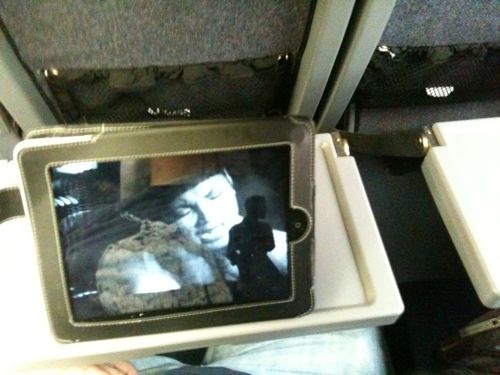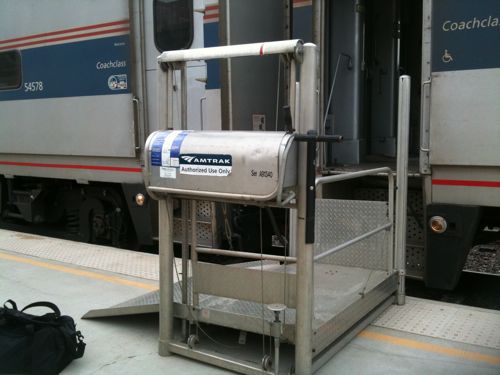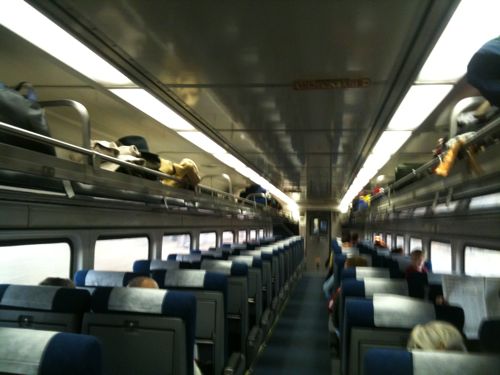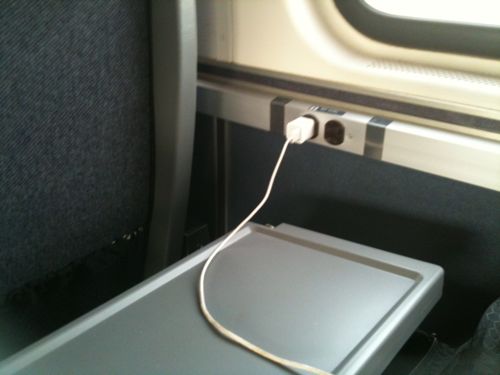Travel By Train Good For Urban Centers

Recently I took a weekend trip to Kansas City. Â I’d driven there many times and I’ve flown there once. Â But have you been to the Kansas City airport? It is located more than 20 miles north of downtown Kansas City and the bus ride takes more than an hour! Â For this trip I took Amtrak.
The train trip was longer than if I had driven my car (6 hours vs 4 hours 15 min), but the convenience was worth it. Â First, I could read, stay current on email, watch music videos, take pictures and arrive at my destination refreshed. Â Apparently, I’m not alone:
In the fiscal year ending Sept. 30, Amtrak served more than 28.7 million riders, an increase of 5.7% from 2009, according to a company statement. Ticket revenue grew 9%, to $1.7 billion. Ridership on the Acela, Amtrak’s higher-speed train, was up 6.6%. Manieri says the ability to stay connected by phone and Internet while traveling is just one reason she prefers the train over flying or driving.
“You can make phone calls, and you don’t have to turn your laptop on and off,” says Manieri, adding she also avoids the airport’s long security lines and the highway’s congestion.
Amtrak has benefited from the “remarkable lifestyle shift” caused by smartphones, laptops and iPads that let travelers work and communicate almost everywhere, says Joseph Schwieterman, a transportation professor at DePaul University in Chicago. “It’s kind of a have-iPhone-will-travel kind of thing.”
Young adults especially view trains and intercity buses as extensions of the public transportation system, he says. They can hop on without ever disconnecting from the rest of the world, he says. (Amtrak chugs along nicely to record ridership)
My last train trip was to Chicago, nearly a decade earlier. Â That trip was a disaster, arriving about 6-7 hours late. But this trip was punctual to the minute. Â By taking my train I was able to have my power wheelchair with me, saving the hassle of parking and of my limited walking distance.




Future trips will be by planes, trains & automobiles. Once Amtrak service in Missouri & Illinois gets wi-fi like trains on the east coast I think we will see more and more opting for train travel.  More people traveling from urban center to urban center will only help those  cities, without hurting the suburban edge.  Next week I will look at Kansas City’s BRT (Bus Rapid Transit) line.
– Steve Patterson
Plus you aren't forced to view all those hideous billboards on I-70.
“Welcome to Missouri, the Billboard State!” Seriously, is there any other state with more billboards per linear mile along ALL Interstates, and most major state arterials?
Amtrak is currently in the process of doing a complete ADA upgrade to all noncompliant stations across the US.
i've taken the train to/from KC several times. it's a great ride, and if you have the time, much more relaxing than driving. every time i've taken it, it has arrived within 15 minutes of it's scheduled time. Now, the train to chicago, that's a whole different story. I rode it in october. an hour late on the way up, 5 hours late on the way home. the train was rerouted due to track construction, but that wasn't mentioned at the time of purchase. we sat in a freight yard 20 miles south of chicago for 3 hours while they waited for a different conductor. ridiculous.
I've taken the train to Chicago dozens of times and typically arrive there faster than KC and on time 85% of the time. Recently there has been a lot of construction on that track, however. Glad you had a good experience on STL-KC, that line was nearly unrideable until recently…I'm talking routine 8 hour delays.
8 hour rides, rather.
FYI, not all of the coaches used on River Runner have power outlets. If you need to be absolutely assured of power, spend a few bucks on the business class upgrade.
Can you imagine how many more people would use the STL/KC line if they had routed it through Columbia?
6?
But seriously, it could (have) be(en) big on game days, maybe 10 days a year, but not so much on other days. And the tradeoff is/would've been slower service between the two big cities.
And that is the big challenge for rail travel, in general. With good roads, broad ownership of personal vehicles and suburban sprawl, on either the origin end and/or the destination end of the trip, driving oneself still remains highly attractive for trips of 400-500 miles or less. IF the stations are convenient on both ends, then yes, rail is great. But if it takes a half hour or an hour to get to the station, then you have to pay to park, then you have to wait to board, then you have to rent a car on the other end, then drive another half hour, hour, or more, on the other end, it's not much different than flying – more expensive and a pain in the a**, and all you avoid is the TSA BS!
Steve's right, train travel IS good for urban centers – that's how they grew originally, and that's one aspect that can help reinvigorate them now. Whether the general translates into the specific here depends on multiple decisions and, apparently, significant public investment, in high-speed intercity rail, in low-speed urban rail, in our local bus system, in local land use, in where jobs are located, attitudes on suburban sprawl, and local pereceptions on crime and race. There is no one answer, but a whole bunch of interrelated issues . . .
I know I would have used the train to and from Columbia and St. Louis instead of driving. And I think a lot of people would for visiting home on weekends, holidays, etc…
Certainly more than use it in J-Town, anyway
I'm open to correction but, I do believe that there is literally _no_ railroad (freight-or-otherwise) right-of-way that currently serves Columbia.
In the long past, Columbia was served by two stub lines, one down from Moberly and one up from the Missouri Bottoms down somewhere near McBain. Each was a stub-end track with no space available for the trackage needed for turning trains around. In the old days, passenger trains backed into Columbia and pulled out when they departed.
The RR along the left bank of the Missouri was long-ago totally abandoned and dismantled, leaving only the RR at Moberly to be a possible-but-highly-unlikely starting point for planning a service that includes Columbia.
Then, begin imagining the problems of right-of-way property acquisition in this day and age.
And finally, other than Columbia the other towns along that route would account for minimal passenger traffic; based on in-place right-of-way, the route is StL, St Charles, Mexico, Moberly/Columbia/Moberly, no-place (I don't mean to be offensive) then till, KC.
between columbia and KC i could see stops in boonville, higginsville (with a spur down to warrensburg maybe), and some of lone jack/odessa/blue springs/independence areas. i went to college in warrensburg and knew several kids without cars who would use the train to get back to St. Louis or Jeff City. however, that was in the days before megabus.
Again, please correct me where I am incorrect.
There _is_ no existing RR line between Columbia and Booneville. The _only_ RR with a line into Columbia is a spur down from the north way up at Centralia.
I suggest looking at the two RR maps of Missouri which are published by MODOT.
<<http: documents=”” maprail_passenger_dated11_15_07.pdf=”” othertransportation=”” rail=”” http://www.modot.mo.gov=“”>>
and
<<http: documents=”” othertransportation=”” rail=”” rail_freight_061809.pdf=”” http://www.modot.mo.gov=“”>>
Warrensburg is already currently served by the AMTRAK service operating between StL and KC via Washington and Jeff City.</http:></http:>
I am not saying that there is – I am merely pointing out that it is a shame that the train that connects St. Louis and KC misses Columbia (the one town in the state that has the most St. Louis and KC natives other than STL and KC) by 30 miles.
If the main line doesn't go thru or near Columbia, the only way it could be served is with a spur line, and that only makes sense if there's enough demand every day for the service. The challenge, for any college town, is that demand is wildly inconsistent, day-to-day . . .
Steve took business clas Amtrak to and fro to KCMO in th elast year and the experience was one I am anxious to repeat. dm